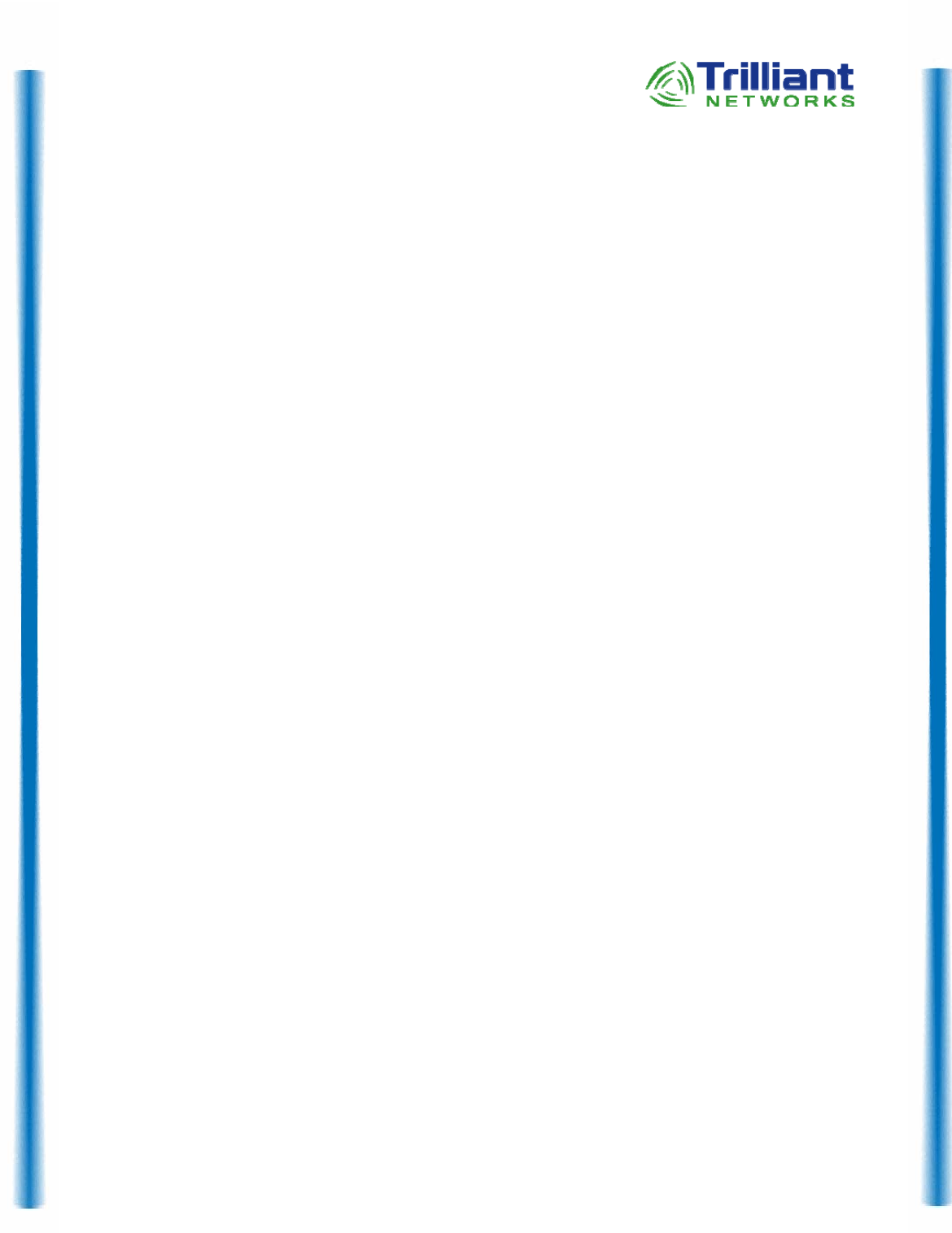Trilliant Networks EM000033 Transceiver Module User Manual installation instructions
Trilliant Networks Transceiver Module installation instructions
Manual

Trilliant Networks 22dB Radio Module
In
sta
ll
at
i
o
n In
st
r
uct
i
o
n
s
Ma
y
16
,
2007
The Trilliant Networks 22dB Radio Module is a 2.4GHz 802.15.4 data transceiver module. It is
designed to be used in products such as electric meters, gas meters, thermostats, etc. The module
contains a trance antenna or optional U.FL connector. Power is supplied by a host module with a
nominal operating voltage of 3.3 volts.
Specification of the radio includes:
IEEE Standard: 802.15.4
Power Output: +22 dBm
Radio Sensitivity: -101 dBm
RF Data Rate: 250kbps
Operating Frequency: 2.4-2.485 GHz
Bit Error Rate: 7*10-7 @92dBm
Network Topology: Mesh, Point to Point
Spread Spectrum: Direct Sequence
Modulation: O-QPSK
Radio Dimensions: 1.0” x 1.5”
Antenna Options: Directional trace antenna or U.FL external
Compliance Statement (Part 15.19)
This device complies with Part 15 of the FCC Rules. Operation is subject to the following two
conditions:
1) This device may not cause harmful interference.
2) This device must accept any interference received, including interference that may cause
undesired operation.
FCC Interference Statement (Part 15.105 (b))
This equipment has been tested and found to comply with the limits for a Class B digital device,
pursuant to Part 15 of the FCC Rules. These limits are designed to provide reasonable protection
against harmful interference in a residential installation. This equipment generates uses and can
radiate radio frequency energy and, if not installed and used in accordance with the instructions,
may cause harmful interference to radio communications. However, there is no guarantee that
interference will not occur in a particular installation. If this equipment does cause harmful
interference to radio or television reception, which can be determined by turning the equipment
off and on, the user is encouraged to try to correct the interference by one of the following
measures:
- Reorient or relocate the receiving antenna.
- Increase the separation between the equipment and receiver.
- Connect the equipment into an outlet on a circuit different from that
to which the receiver is connected.
- Consult the dealer or an experienced radio/TV technician for help.
OEM Responsibility to the FCC Rules and Regulations
The 22 dB Radio Module has been certified per FCC Part 15 rules for integration into products without
further testing or certification. To fulfill the FCC certification requirements the OEM of the 22 dB Radio
Module must ensure that the information provided on the 22 dB Radio Label is placed on the outside of
the final product.
The 22 dB Radio Module is labeled with its own FCC ID Number. If the FCC ID is not visible when the
module is installed inside another device, then the outside of the device into which the module is
installed must also display a label referring to the enclosed module. This exterior label can use wording
such as the following:
“Contains Transmitter Module FCC ID: TMB-EM000033”
or
“Contains FCC ID: TMB-EM000033”
The OEM of the 22 dB Radio Module must only use the approved antenna, which has been certified
with this module.
The OEM of the 22 dB Radio Module must test their final product configuration to comply with
Unintentional Radiator Limits before declaring FCC compliance per Part 15 of the FCC rules.
Warning (Part 15.21)
Changes or modifications not expressly approved by the party responsible for compliance could void
the user’s authority to operate the equipment.
RF Exposure (OET Bulletin 65)
To comply with FCC RF exposure requirements for mobile transmitting devices, this transmitter
should only be used or installed at locations where there is at least 20cm separation distance between
the antenna and all persons.
Industry Canada Statement
The term “IC” before the certification/registration number only signifies that the Industry Canada
technical specifications were met.
Section 7.1.5 of RSS-GEN
Operation is subject to the following two conditions:
1) this device may not cause harmful interference, and
2) this device must accept any interference received,
including interference that may cause undesired operation.
Section 7.1.4 of RSS-GEN
This device has been designed to operate with an antenna having a maximum gain
of [2.0] dB. Antenna having a higher gain is strictly prohibited per regulations
of Industry Canada. The required antenna impedance is [50] ohms."
Section 7.1.5 of RSS-GEN
To reduce potential radio interference to other users, the antenna type and its gain should be so
chosen that the equivalent isotropically radiated power (EIRP) is not more than that required for
successful communication.
Trilliant Networks, Inc. 950 Rue Cowie Granby, Quebec J2J 1P2 Canada Phone (450) 375-0556